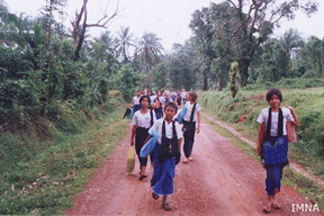Mon schools throughout Mon State have seen an increase in funding from local community members, providing more money for schools that had previously been dependent on funding from an educational committee administered by the largest Mon ceasefire group.
 Schools administered by the Mon National Education Committee (MNEC), which is administrated by the New Mon State Party (NMSP), have reported a significant increase in funding from donations by parents of students and local communities. According to members of the MNEC and parents, the windfall for Mon schools is the increasing inability of parents to pay for regular schools run by the Burmese State Peace and Development Council (SPDC).
Schools administered by the Mon National Education Committee (MNEC), which is administrated by the New Mon State Party (NMSP), have reported a significant increase in funding from donations by parents of students and local communities. According to members of the MNEC and parents, the windfall for Mon schools is the increasing inability of parents to pay for regular schools run by the Burmese State Peace and Development Council (SPDC).
“The parents who have no many like me, we send our children at Mon school, [because] the schools don’t take more money, not like the school control under the SPDC,” explained one student’s parent. “The SPDC schools took money from the students, but we needed the schools … for our children’s futures, if we have no school like [Mon schools], our children won’t be able to learn.”
According to the MNEC vice chairman, the cost difference for students between state run SPDC schools and MNEC financed Mon schools is drastic, “For students who attended the SPDC school, they spent more than 2 million kyat per year while at the MNEC school they need to provide for approximately 200,000 to 300,000 kyat. That’s why many parents send their children to MNEC school’s.”
According to statistics from MNEC enrolment for the 2009-2010 school year, about 36,000 students attended MNEC controlled schools. Currently the MNEC funds 272 schools in Mon state which employ 789 teachers. 154 of the schools teach a course plan designed by the MNEC, while the remaining 118 teach regular SPDC courses.
The teachers in schools funded by the MNEC are paid every 3 months, approximately 600 bath per month, and are on salary for 10 months of every year.
Student’s parents are reported to have donated money for salaries and rice to support village teachers either out of pocket or from community efforts to raise money for local schools.
The topic of funding for MNEC schools has been heavily scrutinized the last two months, after fears about possible budget shortfall was released. In November IMNA spoke with committee members in Pa-nga village in Thanphyuzayart township, who rallied to fund their local Mon schools after they were warned about potential budget gaps.
In early December the Irrawaddy news magazine published a story announcing that donors had cut funding, however the MNEC vice chairman denied this, stating, “Some news agencies published information that the donors who help MNEC education, cut off their [funding] program, but that’s not true. We are now getting the money from the donors regularly.”
To clarify the MNEC vice chairman explained to IMNA that the 2 International NGO’s mentioned in the Irrawaddy article have donated to the MNEC, yet operation costs of the schools continue to be high. However, MNEC vice chairman explained that student’s parents have taken on a large portion of funding for their children’s education, donating money for teachers’ salaries and rice, allowing schools to continue to function run the same situation before.
This increase in support available to Mon schools from community members has allowed greater independence from MNEC administration and funding. MNEC vice chairman explains how significantly funding has benefited the MNEC system, “If the donor cut off their donations, we could still control our education because now we only receive a little of our money from donors – it’s not enough [to only] support our program. We get from donors one third of our budget while we get two thirds from the student’s parents.”
In particular though, this independence could give the Mon school system the opportunity to weather potential political unrest.
The NMSP has come under increasing pressure from the SPDC military government to realign its armed wing, the Mon National Liberation Army (MNLA), as a border guard force. This heavily disputed move would reduce MNLA battalions to 326 members and command given to 18 SPDC officers.
This increased pressure on the NMSP has come as the SPDC hopes to resolve the issue of the numerous ethnic ceasefire groups located along its borders, before the election slated for 2010.
In numerous public appearances over the last 2 months, senior administrators from the NMSP have met with constituents thought Mon state, speaking on the topics of the NMSP’s rejection of both the border guard force proposal, and possible NMSP participation in the 2010 election.
Addressing this shift towards public funding for Mon schools, the MNEC vice chairman stated, “If the situation between NMSP and SPDC will change for the coming 2010 election, in that situation the MNEC school could meet with problems. That’s why the MNEC hopes [for this to continue] and the schools to not be MNEC schools, but student’s schools.”



